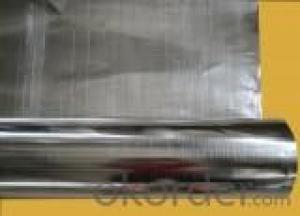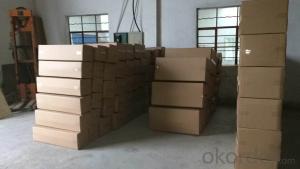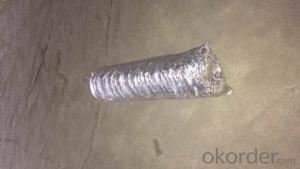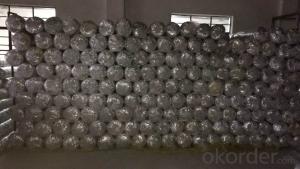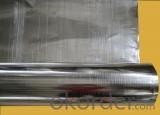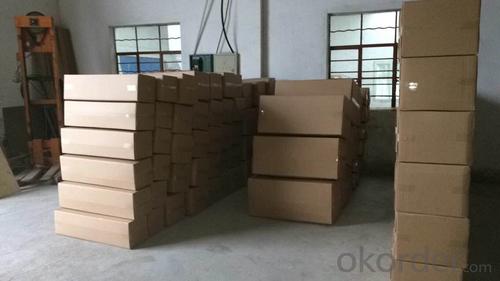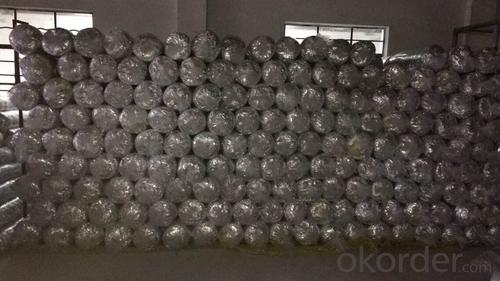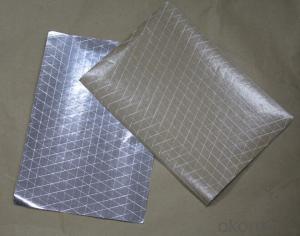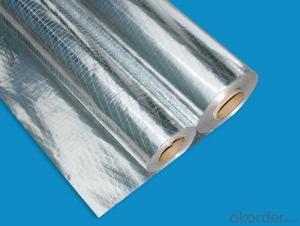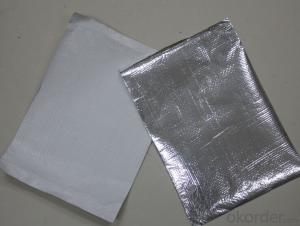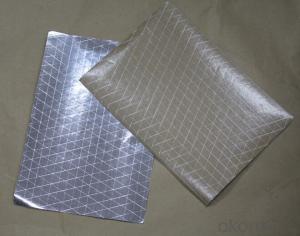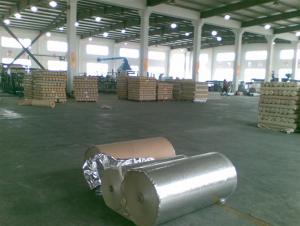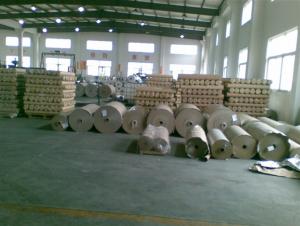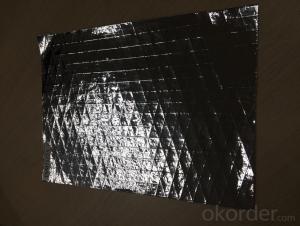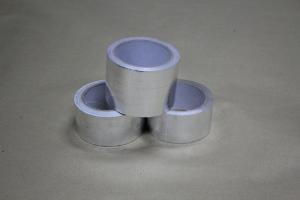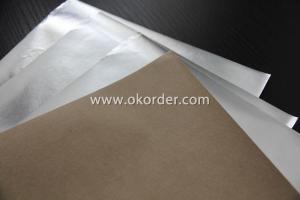Aluminum Foil Facing Insulation Flexible Ducts Bubble Foil Mylar Al+Pet+Ldpe
- Loading Port:
- Tianjin
- Payment Terms:
- TT OR LC
- Min Order Qty:
- 12 m²
- Supply Capability:
- 30000 m²/month
OKorder Service Pledge
OKorder Financial Service
You Might Also Like
).Raw material for Aluminium: 1235-0, 8011
Raw material for PET: New PET ,OPP is also available
2).Different kinds:
| structure | Normal laminated thickness | Width | Length | Color | ID | OD | Packin |
| AL+PET+LDPE | 7umAlu+15umPet+3umGlue | 6mm-1000mm as your required | 500m-7000m | Silver blue bronze black others | 2"or3" | 250mm-600mm | polybag caron pallet
|
| 9umAlu+12umPet+3umGlue | |||||||
| AL+PET+AL | 6umAlu+15umPet+6umAlu+6umGlue | ||||||
| PET+AL+PET | 15umPet+7umAlu+15umPet | ||||||
| AL+PET+EAA | 7umAL+15umPET+25umEAA+6umglue | ||||||
| AL+PET+AL+EAA | 7umAlu+15umPET+7umAlu+25umEAA+9umglue | ||||||
| PET+PET | 15umPet+15umPet +3umGlue | ||||||
| Polyester Tape | 15um,18um |
3).Certificaton: SGS
4).Specifications:
The following is the single side aluminium mylar tape specifications for you take reference:
Description: Al+PET Tape(AL/myler Tape) | ||||
Composition:aluminium foil and polyester film | ||||
Structure | Thickness(um) | Proportion(g/m2) | Elongation(%) | Strength(N/15mm) |
6um AL/12um PET | 20 | 36 | 30 | 2.7 |
7um AL/15um PET | 25 | 43 | 35 | 2.7 |
7um AL/20um PET | 30 | 50 | 35 | 3 |
9um AL/12um PET | 25 | 45 | 30 | 2.7 |
9um AL/15um PET | 30 | 49 | 35 | 3 |
9um AL/20um PET | 35 | 55 | 35 | 3 |
9um AL/25um PET | 38 | 62 | 35 | 4 |
12um AL/12um PET | 25 | 53 | 20 | 2 |
12um AL/15um PET | 30 | 57 | 20 | 3 |
12um AL/20um PET | 35 | 63 | 30 | 4 |
15um AL/15um PET | 30 | 65 | 20 | 3 |
25um AL/15um PET | 45 | 92 | 20 | 3 |
30um AL/25um PET | 60 | 119 | 20 | 3 |
30um AL/30um PET | 65 | 126 | 20 | 5 |
40um AL/30um PET | 75 | 153 | 20 | 5 |
40um AL/38um PET | 80 | 163 | 20 | 5 |
50um AL/25um PET | 90 | 173 | 20 | 5 |
50um AL/50um PET | 100 | 207 | 35 | 6 |
Above values refer to our current production and must be intended as average values | ||||
The reference is not including all specification. | ||||
- Q: What are the recommended cleaning products for aluminum foil facing after use?
- <p>For cleaning aluminum foil facing after use, it's best to use gentle, non-abrasive cleaning products. Mild dish soap and warm water are usually sufficient for most cleaning needs. Avoid using harsh chemicals or abrasive scrubbers, as they can damage the aluminum surface. If there are stubborn stains, a mixture of baking soda and water can be used as a gentle abrasive. Always rinse thoroughly and dry the surface to prevent any residue or potential damage.</p>
- Q: What are the potential health advantages of utilizing recycled aluminum items for cooking or baking purposes?
- <p>Using recycled aluminum products for cooking or baking can have some health benefits. Recycled aluminum is generally considered safe as it undergoes a thorough purification process to remove any contaminants. It is also more environmentally friendly, reducing the need for mining new aluminum, which can have negative health impacts due to the chemicals used in the extraction process. Additionally, recycled aluminum products can be more cost-effective, making them accessible to a wider range of consumers. However, it's important to ensure that the recycled aluminum products are from reputable sources and meet safety standards to avoid any potential health risks.</p>
- Q: This question asks for the optimal method of storing aluminum foil to maintain its usability and prevent damage.
- <p>The best way to store aluminum foil is to keep it in a cool, dry place, away from direct sunlight and heat sources. It's advisable to store it in its original box or a resealable plastic container to prevent it from getting crumpled or damaged. Some people prefer to store it with the shiny side facing out for easier identification, while others prefer the dull side out to reduce glare. It's important to ensure that the foil is tightly rolled to prevent it from unraveling or getting tangled.</p>
- Q: Is it possible to use aluminum foil with a reflective side for baking purposes? If yes, what is the method of using it?
- <p>Yes, aluminum foil facing can be used for baking. To use it, place the foil shiny side up on the baking sheet to reflect heat and promote even cooking. It can also be used to cover the food to prevent over-browning or to create a steaming effect, which can help in cooking delicate items. Remember to use it carefully as it can get very hot and can cause burns. Always handle with oven mitts and avoid direct contact with the foil.</p>
- Q: This question is asking for instructions on how to clean and store aluminum foil rolling film to maintain its quality and usability.
- <p>To clean aluminum foil rolling film, gently wipe it with a damp cloth to remove any residue. Avoid using abrasive materials that could scratch the surface. After cleaning, let it dry completely. To store, roll the film tightly and wrap it in a protective layer, such as a plastic wrap or a clean cloth, to prevent dust and scratches. Store it in a cool, dry place away from direct sunlight to maintain its integrity.</p>
- Q: Explain the distinctions between aluminum foil facing and plastic wrap, including their composition, uses, and properties.
- <p>Aluminum foil facing is a thin layer of aluminum used for insulation, moisture protection, and as a barrier to light and air. It is commonly used in construction and food packaging for its heat and cold resistance. Plastic wrap, on the other hand, is made from plastic polymers like polyethylene and is primarily used for food storage, keeping food fresh by sealing in moisture and preventing contamination. Unlike aluminum foil, plastic wrap is transparent, clingy, and does not conduct heat, making it unsuitable for cooking or insulation purposes.</p>
- Q: This question asks for the most effective method to smooth out wrinkles in aluminum foil facing material.
- <p>The best way to remove wrinkles from aluminum foil facing is to use a combination of heat and gentle stretching. First, preheat your iron on a low setting without steam. Place a thin cloth or parchment paper over the wrinkled aluminum foil facing to protect it from direct heat. Then, gently press the iron over the cloth, moving in a smooth, continuous motion. As the foil warms, it will become more pliable, allowing you to gently stretch and smooth out the wrinkles. Be cautious not to apply too much pressure or heat, as this can damage the foil.</p>
- Q: What are some effective techniques or suggestions for utilizing aluminum foil in various applications?
- <p>Using aluminum foil effectively involves a few tricks: 1) For cooking, use a double layer to prevent food from sticking and to distribute heat evenly. 2) When grilling, crumple the foil to create a heat-reflective dome for indirect cooking. 3) Line baking sheets with foil to simplify cleanup. 4) Use foil to create makeshift containers for baking, such as foil packets for vegetables or fish. 5) For storage, wrap food tightly to preserve freshness. 6) When roasting meats, tent with foil to lock in moisture. 7) Use foil to create a barrier between food and the grill grates to prevent flare-ups. Remember, avoid using foil with acidic foods as it can react and release aluminum into the food.</p>
- Q: What are the considerations or safety measures one should take into account when using aluminum foil in the kitchen for cooking purposes?
- <p>When using aluminum foil for cooking, it's important to avoid direct contact with acidic or alkaline foods as this can cause the foil to corrode and potentially release aluminum into the food. Also, refrain from using foil with non-stick cookware as it can damage the non-stick surface. Ensure that the foil is not wrapped too tightly around food, especially when cooking in the oven, to prevent uneven cooking. Avoid using foil with sharp edges or corners that could tear. Lastly, do not use aluminum foil in the microwave for long periods or with high power as it can cause sparks or fires. Always follow the manufacturer's guidelines for safe use.</p>
- Q: This question asks for a comparison between domestic and foreign aluminum foil, specifically focusing on their differences.
- <p>The differences between domestic and foreign aluminum foil facing primarily lie in material quality, manufacturing processes, and market positioning. Domestic aluminum foil often uses locally sourced materials and may have variations in thickness and quality, while foreign foil might employ higher-grade materials for enhanced durability and consistency. Manufacturing processes abroad may incorporate advanced technology, leading to better surface smoothness and uniformity. Additionally, foreign aluminum foil is often marketed as premium, targeting niche segments with specific requirements for quality and performance. Domestic foil, on the other hand, is generally more affordable and caters to a broader market, including everyday household use.</p>
Send your message to us
Aluminum Foil Facing Insulation Flexible Ducts Bubble Foil Mylar Al+Pet+Ldpe
- Loading Port:
- Tianjin
- Payment Terms:
- TT OR LC
- Min Order Qty:
- 12 m²
- Supply Capability:
- 30000 m²/month
OKorder Service Pledge
OKorder Financial Service
Similar products
Hot products
Hot Searches
Related keywords
